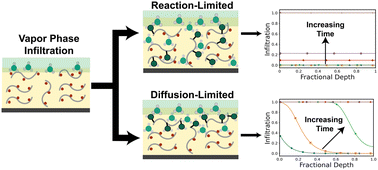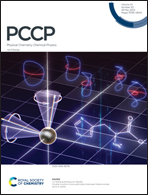Interpreting inorganic compositional depth profiles to understand the rate-limiting step in vapor phase infiltration processes†
Abstract
Vapor phase infiltration (VPI) is a post-polymerization modification technique that infuses inorganics into polymers to create organic–inorganic hybrid materials with new properties. Much is yet to be understood about the chemical kinetics underlying the VPI process. The aim of this study is to create a greater understanding of the process kinetics that govern the infiltration of trimethyl aluminum (TMA) and TiCl4 into PMMA to form inorganic-PMMA hybrid materials. To gain insight, this paper initially examines the predicted results for the spatiotemporal concentrations of inorganics computed from a recently posited reaction–diffusion model for VPI. This model provides insight on how the Damköhler number (reaction versus diffusion rates) and non-Fickian diffusional processes (hindering) that result from the material transforming from a polymer to a hybrid can affect the evolution of inorganic concentration depth profiles with time. Subsequently, experimental XPS depth profiles are collected for TMA and TiCl4 infiltrated PMMA films at 90 °C and 135 °C. The functional behavior of these depth profiles at varying infiltration times are qualitatively compared to various computed predictions and conclusions are drawn about the mechanisms of each of these processes. TMA infiltration into PMMA appears to transition from a diffusion-limited process at low temperatures (90 °C) to a reaction-limited process at high temperatures (135 °C) for the film thicknesses investigated here (200 nm). While TMA appears to fully infiltrate these 200 nm PMMA films within a few hours, TiCl4 infiltration into PMMA is considerably slower, with full saturation not occurring even after 2 days of precursor exposure. Infiltration at 90 °C is so slow that no clear conclusions about mechanism can be drawn; however, at 135 °C, the TiCl4 infiltration into PMMA is clearly a reaction-limited process, with TiCl4 permeating the entire thickness (at low concentrations) within only a few minutes, but inorganic loading continuously increasing in a uniform manner over a course of 2 days. Near-surface deviations from the uniform-loading expected for a reaction-limited process also suggest that diffusional hindering is high for TiCl4 infiltration into PMMA. These results demonstrate a new, ex situ analysis approach for investigating the rate-limiting process mechanisms for vapor phase infiltration.



 Please wait while we load your content...
Please wait while we load your content...